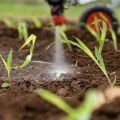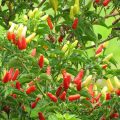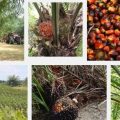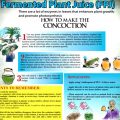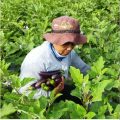
Introduction
In the past few years, agriculture has witnessed a paradigm shift due to blending with Artificial Intelligence. AI is reinventing conventional agricultural practices from precision farming to automated machinery and offers novel answers to ancient problems. This blog discusses how AI is changing agriculture and gives insights into how farming will be in future.
According to Growth Market Reports, “ The global artificial intelligence in agriculture market size was valued at USD 1.38 billion in 2022 and is estimated to reach USD 8.96 billion by 2031, expanding at a CAGR of 23.1% during the forecast period, between 2023 – 2031.”
Precision Farming
Precision farming is among the most significant contributions of AI in agriculture. Traditional farming methods often resulted in inefficiency and wastage of resources because they were based on a one-size-fits-all model. However, AI allows farmers to manage crops more accurately and specifically.
In soil health, weather conditions and crop growth patterns, AI processes information received through sensors, drones or satellite images. This gives farmers an opportunity for making data-based decisions which are relevant to the opportunity of optimizing irrigation, fertilization as well as pest control. The result is enhanced agricultural production with reduced environmental impacts and improvement in overall resource utilization efficiency.
Automated Machinery
Agriculture has also been transformed by AI-driven automated machines. Tasks that used to be laborious have been made simpler and quicker by the rise of smart tractors, harvesters, and drones. These machines function autonomously due to guidance from algorithms developed by AI that ensure accuracy and speed while executing tasks.
For example, autonomous tractors with built-in AI can navigate across fields; plant seeds at optimum depths even changing their operations through real-time data analysis concerning prevailing conditions. Consequently, this boosts productivity while reducing human dependence on them thus enabling such strategic aspects to prevail over time.
Crop Monitoring and Disease Detection
AI has a crucial part to play in the monitoring of crop health and early detection of diseases. By use of AI algorithms on drones and sensors, high-resolution images can be taken of crops thus allowing farmers to identify possible signs like low nutrients, pest invasion or diseases.
Learning algorithms that examine these images recognize patterns associated with various crop diseases. Timely identification of issues allows for targeted interventions by farmers thus cutting down on the need for widespread chemical use and reducing crop losses. This proactive approach to managing crops improves the overall sustainability of agriculture production.
Supply Chain Optimization
AI’s application is not just limited to farm level; it has also contributed towards optimizing the entire agricultural supply chain. From planting up to distribution, AI algorithms can analyze huge amounts of data thereby enhancing efficiency in logistics, minimizing wastage as well as improving general management of supplies.
With predictive analytics powered by AI, it becomes easier for farmers to plan for harvest and distribution based on expected yields. Additional tools driven by AI make it possible for stock levels to be monitored in real time while ensuring produce is transported and preserved under ideal circumstances. Consequently, there is less loss due to rottenness, lower overhead costs incurred in this process while the agricultural supply chain becomes much more flexible.
Weather Prediction and Climate Adaptation
Uneven weather patterns brought about by climate change pose substantial challenges to agriculture since it affects crop yields. AI comes as a savior by providing advanced weather forecasting models based on historical data and real-time observations.
AI-generated forecasts can be used by farmers for making informed decisions regarding their planting times, irrigation schedules, and harvest planning. This does not only help alleviate the effects of harsh weather conditions but also makes it possible for farmers to adjust to altered climatic conditions more effectively.
Improved Resource Management
AI in agriculture optimizes the use of water, fertilizers, and other inputs leading to more efficient resource management. With real-time monitoring and analysis, AI systems can accurately determine how many resources are needed for specific areas of a farm. By so doing, this accuracy level enables farmers reduce unnecessary consumption of resources which in turn cuts costs reducing environmental degradation.
For instance, AI-driven irrigation systems can change water levels according to the moisture content of soil dynamically. It not only conserves water but also prevents over-irrigation that is detrimental to soil health. Likewise, AI-based nutrient management systems ensure that fertilizers are applied at appropriate rates and timely intervals leading to healthier crops and reduced nutrient leaching.
Enhanced Decision-Making with Big Data
Today’s farming produces a lot of data. AI is great at handling this and pulling out the useful stuff. Farmers can use big data to pick crops, watch the market, and run their farms better.
AI can mix data from different places like weather reports, market costs, and old crop records. This gives farmers good tips and hints. They can then make better decisions, find new chances, and avoid problems, making farming better and safer.
Increased Accessibility for Small Farmers
Big farms can usually buy high-tech farm equipment, but AI can help tiny farms too. Handy apps and AI on the internet allow poor farmers to find out necessary details and guidance.
Take A Iphone apps. They show little farmers the weather, bad bug warnings, and what crops sell for. This spreads knowledge. Farmers can make smarter choices, get more done, and earn more. As AI tools get cheaper and easier to get, even the smallest farms should benefit.
Collaboration and Knowledge Sharing
AI helps farmers and farm experts share ideas, globally. Web platforms and networks use AI to share top methods, fresh ideas, and research findings. This web of connections strengthens a group-based way to solve problems. Farmers learn from each other and work together to solve problems.
Also, platforms driven by AI can gather data from many places, making a full information center for the farming community. This shared information helps everyone understand more about farming. It allows continuous growth and new ideas in the industry.
Conclusion
Artificial Intelligence (AI) is doing more than adding tech to farming. It’s changing the way we grow food. AI helps make farming accurate and automatic. It also helps farm-related decisions to be based on facts and data. As farming keeps changing, AI has a big role in handling world food needs and making farming sustainable.
How? By managing resources better, making smarter decisions based on big data, and making it easier for all farmers to use. AI makes farming more innovative. Platforms run by AI also promote sharing what we know and building a community. This makes a farming world that’s more linked up and well-informed.
The modern-day rise in farming technologies underlines that AI isn’t just a tool. It’s like a spark that ignites positive transformations. The shifts that AI brings to farming showcase just how we can evolve and innovate. This adaptation leads to a fruitful and more sustainable future in global food production.
